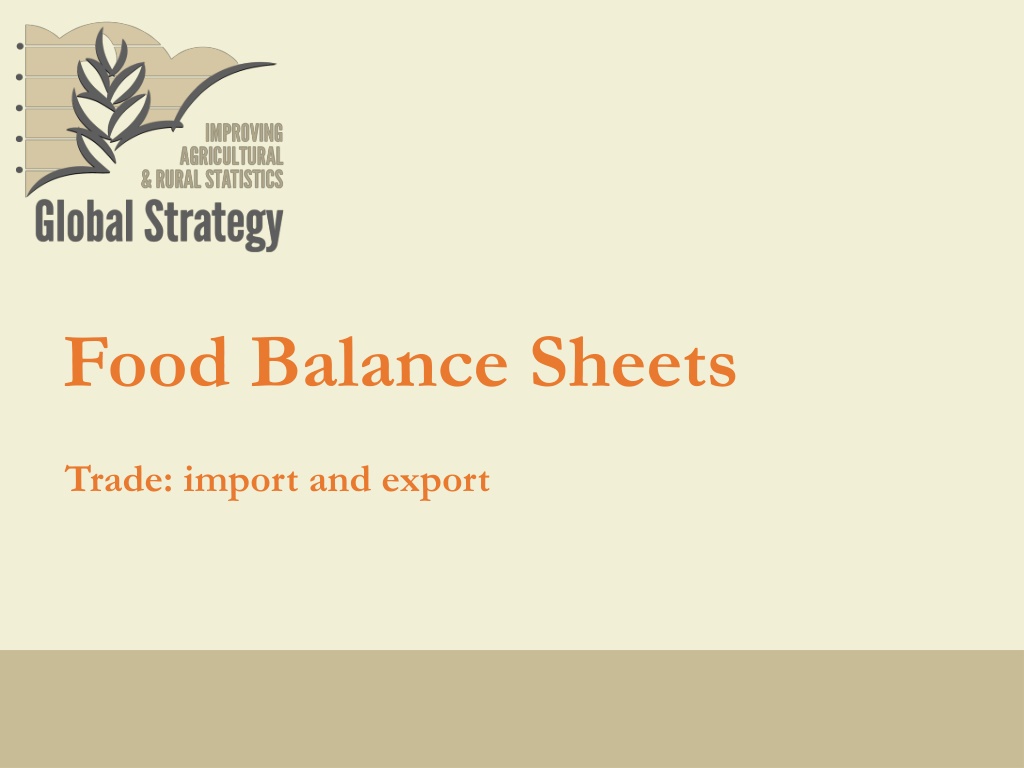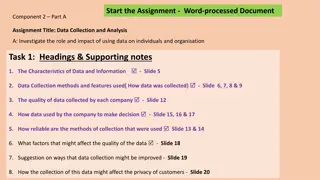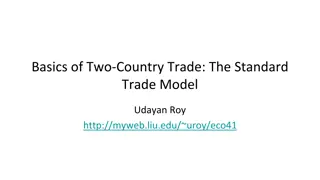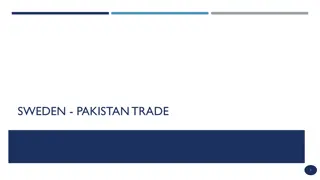Understanding Trade Data: Importance, Collection, and Sources
Explore the significance of trade data, differences between official and unrecorded trade resources, and the mirroring technique for handling missing data. Delve into main features, official data sources, and alternative methods for accurate trade data. Learn how countries collect trade data, why it's crucial, and the implications of unrecorded trade on food security.
Uploaded on Sep 22, 2024 | 0 Views
Download Presentation

Please find below an Image/Link to download the presentation.
The content on the website is provided AS IS for your information and personal use only. It may not be sold, licensed, or shared on other websites without obtaining consent from the author. Download presentation by click this link. If you encounter any issues during the download, it is possible that the publisher has removed the file from their server.
E N D
Presentation Transcript
Food Balance Sheets Trade: import and export
Learning objective Participants will learn: a) What TRADE data are, why are important, and how countries collect them b) The difference between official trade data and unrecorded trade resources c) What mirroring technique means and how it can help in case of missing data 2 2
Outline Trade (Import and Exports): 1. Main features of trade data 2. Official data sources 3. Importance of accurate data 4. Alternative data sources 5. Imputation and estimations 3 3
1. Main features of trade data Trade data are the most likely to be reported reliably by official sources Tax purposes, compliance with WTO and WCO guidelines !!! However, particularly in trade of agricultural goods, official reported trade flows may not encompass all cross- border transaction UNRECORDED TRADE Example: Affect a country s food supply and food security 4 4
1. Main features of Trade data UNRECORDED TRADE: Data from other sources (several additional data resources are available) Mirror statistics (data cross-checking tool) 5 5
2. Official data sources A. Customs declaration B. Additional official administrative data C. Official data that estimate otherwise unrecorded trade flows 6 6
2. Official data sources A. Customs declaration Most of the world s countries collect official data on both imports and exports of goods via customs declarations Customs declarations can require the provision of a wide variety of information about a given cross-border transaction, but they must include a commodity code for the product to aid in classification They include a commodity code for the product (HS code) Usually updated and disseminated frequently 7 7
2. Official data sources B. Additional official administrative data Additional official administrative data are: Shipping manifest, shipping registers, port administration reports, enterprise surveys FBS compilers may wish to consult additional official administrative records in the case that potential issues with official customs data are identified 8 8
2. Official data sources C. Official data that estimate otherwise unrecorded trade flows In some cases, countries also produce official data estimating otherwise unrecorded trade flows Example: Uganda, annually conducts an Informal Cross Border Trade (ICBT) survey to collect information about the scope of these trade flows The country s 2014 survey suggested that ICBT exports were nearly one-fifth the size of formal exports, and agricultural goods represented almost half of those unreported trade flows 9 9
3. Importance of accurate data Unrecorded trade flows can be important contributors to: I. Household income II. Localized food security Example: trade data are particularly important for the accurate estimation of livestock population (especially for countries with nomadic populations) For these reasons, official data may need to be supplemented with data from other sources 10 10
4. Alternative data sources FBS compilers who for some reason cannot access national customs data or for compilers who wish to cross-check the data or consult other sources i. International trade databases ii. Mirroring technique iii. Unrecorded trade resources iv. Food aid data 11 11
4. Alternative data sources 4.i.a International trade database: COMTRADE For the majority of the world s countries, official customs data is forwarded to the UN Statistics UN Database Comtrade http://comtrade.un.org/ Comtrade is a comprehensive database, which publishes trade statistics by year, reporting country, partner country, trade flow type (import, export, re-export), and HS code Comtrade data are considered official data 12 12
4. Alternative data sources 4.i.b International trade database: FAO dataset FAO also produces a dataset on agricultural trade This dataset is elaborated on the basis of Comtrade data FAO s dataset attempts to account for food aid and unrecorded trade flows, rendering it a more complete dataset for food balance sheet purposes FAO s dataset contains imputations and estimations, thus it is not entirely an official data source 13 13
4. Alternative data sources 4.ii Mirroring technique Countries are encouraged to check the trade flows reported by their trading partners referred to as mirror data Countries oftentimes tax imports through tariffs, there is a tendency for import data to be more closely and accurately monitored Most exports are not taxed, sometimes those trade flows are not adequately captured, even in official data In those instances, it may make sense for compilers to consult partner data and, investigate the discrepancy, and even override official trade figures 14 14
4. Alternative data sources 4.iii Unrecorded trade resources In countries where unrecorded trade is reported to be substantial, compilers should at least attempt to quantify those values Example: FEWS NET network produces periodic cross-border trade reports for both East and Southern Africa Example: CILSS, for Comit permanent Inter-Etats de Lutte contre la S cheresse dans le Sahel, collects data on unrecorded trade flows between eight West African countries for both major cereal grains and livestock 15 15
4. Alternative data sources 4. iv Food Aid Data For some countries, food aid shipments do not show up in commercial shipment data The World Food Programme (WFP) is the UN Agency that oversees most deliveries of food aid (INTERFAIS website) International Aid Transparency Initiative (IATI) FAO s GIEWS team will begin to collect and publish data on non-WFP food aid shipments 16 16
5. Imputation and estimation FAO recommendation: No methodology is recommended as various datasets already exist 17 17
Reference 1. 3rdchapter of the Guidelines: Data for FBS compilation: considerations, sources and imputation 3.5.2 Trade (Import and Export) page 66 2. FAOSTAT Trade domain http://www.fao.org/faostat/en/#data 18 18























